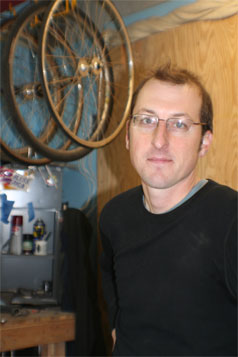

Also in life change:
A two-wheeled existence
 |
|
Photo courtesy of Anne Shapiro
|
Don't tell Kristin Kordet there's no future in agriculture
A family affair
A longtime Wisconsin favorite gets a facelift from new owners
Homegrown hero
Kimberly native Mike Verstegen traded gridiron glory for a storybook life closer to his Wisconsin roots
Get a roll on
A roller derby revival touches down in the capital city
By Joe Hasler
Think back, if you will, to your first bike. Maybe your parents surprised you with the wheels of your dreams for your birthday, or you mowed lawns and saved cash until you could get it yourself. Either way, you couldn’t wait to take it for that inaugural spin. Out the driveway and around the corner you zipped, wind blowing through your hair. You climbed up one side of a hill and then sped down the other with your legs spinning wildly. As you made your descent, unable to move your legs any faster, you stopped pedaling and coasted the rest of the way. Life was perfect.
But bikes aren’t just for kids, though perhaps coasting is. Just take a look around. Single-speed, fixed-gear bicycles—which in the past were mostly exclusive to the realms of steely-nerved bike messengers in big cities and speedy track racers in velodromes—are quickly becoming the hippest way to travel on two wheels.
Equal parts fashion item and transportation device, some “fixies” are rebuilt old bikes. Others are prefabricated rides made by established builders like Bianchi or Surly. Then there’s a third set, the custom-built bike, which often carries a price tag of at least $2,000. For Jon Kendziera, the only full-time custom framebuilder in Wisconsin, the latter group of bikes is a way of life.
Kendziera’s Madison-based business, Jonny Cycles, though relatively new to the custom bike scene, is quickly gaining name recognition. Richard Sachs, a prominent framebuilder with over 30 years of experience, says Kendziera “gets it” and includes him on a list of builders Sachs calls the “next wave.” Sachs is not the only one taking notice of Kendziera’s ability. One need only check out Kendziera’s website to find proof of that. A link titled “See what I’ve been up to lately” keeps a running log not only of current projects—of which there are generally three or four—but also all of his past and future works. As of October, the waiting list was up to 20 with an estimated wait time of 15 months. People want Kendziera’s bikes. And the fixed-gear craze that’s sweeping the nation is definitely a boon for business.
“I’ll say the whole fixed-gears-on the-street trend [hasn’t hurt],” Kendziera says. “I’d say 90 percent of my frames are fixed-gear or track bikes. I think it’ll be popular for a while. I don’t think it’s really going to die out soon.”
For Kendziera, fixed-gear bicycles aren’t just a passing fad. Fixies first entered his life about five years ago while he was working as a mechanic at The Yellow Jersey bike shop in downtown Madison. Soon after, Kendziera took a break from the shop and moved to Seattle for a winter with his wife, Lesley. While she watched her sister’s children, he kept busy riding a fixed-gear and working as a bike courier. It was during his stint as a courier, as he sliced through traffic on his fixed-gear bike and delivered packages, that his love for bikes truly came into fruition.
When he came back to Madison, he resumed his position at Yellow Jersey. It was in Yellow Jersey’s basement that Kendziera built his first bike frame. He’d done frame repair before, but under the watchful eye—not to mention with the tools—of Yellow Jersey owner Andy Muzi, he first learned the basics of bike construction.
“It was kind of like [Muzi] was there for advice, but it wasn’t like he trained me to build frames,” Kendziera says. “I mean, I learned a lot from him and essentially all the equipment was there. I did a lot of research [online], but whenever I had a question I could ask him or he would show me stuff.”
That Kendziera ended up at Yellow Jersey at all was almost dumb luck. Before moving to Madison in 2001, Kendziera had studied mechanical engineering at the University of Wisconsin-Platteville. After graduating, he moved to Chicago and worked for different companies designing conveyor belts and equipment for testing bus seats. But four years of the industrial grind wore on him. So, he and Lesley decided a change of scenery was in order.
“We were down there for three or four years, and then we got tired of the city and working,” Kendziera says. “So out of the blue one day, we were like ‘Alright, we’re moving to Madison.’”
Originally, Kendziera didn’t even plan on working in a bike shop. The pair found an apartment first, then set about finding jobs. Jon, despite having no prior experience, applied at several Madison bike shops. Fortunately for him, Muzi prefers to hire fresh meat because they haven’t learned unbreakable bad habits from other shops. The combination of Kendziera’s inexperience with repairing bikes and his mechanical engineering background made him the perfect job candidate. Little did Muzi know, in just two years, Jonny Cycles would grow out of the basement of his shop.
Starting his own business was never Kendziera’s intention. After doing frame repair for Yellow Jersey, the natural progression was to build his own frame, which he did for the first time in 2003. His friends, several of whom worked for Madison’s bike courier service Scram!, liked what they saw and asked him to build bikes for them too. He complied and built four bikes for his friends, who took them to bike messenger events around the country. Other messengers saw the bikes and wanted to know more about these radical rides. Like any 21st century entrepreneur, Kendziera turned to the web to showcase his work.
“So I started a website to show people what I’d done, not necessarily to sell anything,” Kendziera said. “But then, more and more people were getting interested and it was either: Do it officially and become a business, or only do it for friends. And I just decided to establish a business.”
And so Jonny Cycles was born. Kendziera took out a $4,000 loan to buy basic equipment. He built his first five frames in Muzi’s basement before convincing Jeff Fitzgerald, another Madison bike shop owner, to rent him space in an unheated warehouse. Considering the frigid Wisconsin winters, this was a major hindrance. When Fitzgerald’s shop, Revolution Cycles, moved to a new location in August 2005, Kendziera moved with it. This new workspace came with an added bonus - heat. It’s in this environment that Jonny Cycles has thrived. In lieu of a monthly rent check, Kendziera pays Fitzgerald in manhours worked in his shop. While Fitzgerald is quick to point out the independence of each entity, he’s also tickled to have a framebuilder in his midst.
“There’s something very exciting about the resurgence of more independent framebuilders and a recognition of that—to even see mainstream bicycle companies trying to compete and tap into that market," Fitzgerald says. “It’s definitely rewarding to have that happening here and have [Jonny Cycles] in such a close proximity.”
In the shop, Kendziera’s current projects include a pair of bikes for a father and son in San Diego, as well as a specially built bike for his wife. On average, he spends about 30 hours working on a frame—though it’s not uncommon for him to spend twice or even three times as much time on more-complex jobs. The base rate for a Jonny Cycle is $1,800, but the extra hours mean extra dollars, sometimes as much as $3,000. All of Kendziera’s bikes come with lifetime warranties, and judging by the waiting list, the buying public doesn’t mind paying the price. Peter Brinson, a Madison courier, is one of Jonny Cycles’ first customers. He still rides the bike Kendziera built for him in 2003 and says that of his four bikes, he prefers his Jonny Cycle best.
“It fits me perfectly—much better than other bikes I’ve ridden,” Brinson says. “There’s something … intangible about the way it rides. If I go several days without riding it and I hop back on it, it feels like a million bucks all over again.”
He’s not the only one. At the risk of seeming vain, Kendziera keeps a folder on his computer of all the comments he’s gotten back, which by his count, have all been positive. But even though he’s never made a bike someone didn’t like, he still worries about every bike he sends out. It makes sense when you consider the investment that goes into a bike like the one Jason Sanchez uses to burn up the streets of Milwaukee.
A painter extraordinaire, Sanchez is trained in autobody and paint tech - a vocational background he puts to good use painting the frames Kendziera builds. (Brinson’s purple and silver bike was his first job.) Kendziera wants Sanchez to move to Madison. Sanchez thinks Kendziera should join him in Milwaukee. But Sanchez has a house and Kendziera loves Madison, so nobody's going anywhere anytime soon. The duo talk almost everyday and alternate trips back and forth to make the partnership work efficiently. Combined, Kendziera and Sanchez commit no fewer than 50 hours making each Jonny Cycle bike unlike any other bike. Indeed, when Sanchez describes his bike, he’s almost reverential. Think of the way you felt when you rode your first bicycle. It’s like that, but in a grown-up sort of way.
“It’s just my dream bike,” Sanchez says. “It’s fit to my body dimensions, which no standard production bike is going to give me. Plus, any weird idea we could come up with to make it look cool—for me it was just something lavish that I could do."
Click here to visit a brief timeline breaking down some of the steps of Kendziera's bike building.
home | alternatives | fulfillment | life change | climate | lifestyle
about | subscribe | contact | advertise | site map
_____________________________________________________________
(c) curb magazine 2006